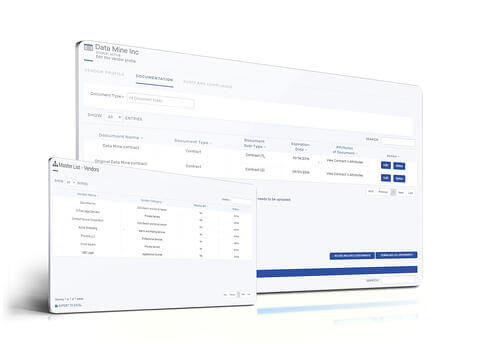A Guide to Picking the Right Vendor Management Software
- December 20, 2021
- Category: Vendor Management

Recommended Reading
Vendor Management Software or a Vendor Management System (VMS) allows companies to manage their vendors including but not limited to collecting requisitions from departments, shortlisting and onboarding new vendors, managing their ongoing performance and compliance. It is typically a web-based, cloud-hosted software that allows collaboration with vendors and third-party servicers. In regulated industries such as credit and collections, vendor management would mean managing the risk associated with third parties by classifying the types of vendors, assessing the risk associated with them, and ensuring vendor performance with due diligence.
History and Evolution of vendor management software
When companies were looking for ways to streamline their vendor management program and reduce their administrative burden using automation, vendor management software came into the picture in the early 1990s when Ford subsidiary called Geometric Results, Inc. (GRI) created a manual vendor management system called PeopleNet. It became automated in 1995 and later was bought by MSXI who then launched it into multiple industries. Soon, hundreds of vendor management software were introduced in the market that helped automate cumbersome external compliance tasks and manage vendors.
Evaluating a Vendor Management Software
There are many vendor management software available, including Contractor Compliance, Gatekeeper, VendorInsight, Procurify, and Kissflow Procurement Cloud, but not all of them have what a company might require to fulfill their needs. For a Small and Medium-sized Enterprise (SME), a tool as sophisticated as SAP Fieldglass may be an overkill. To evaluate the best system for your company, you need to first identify the challenges you face today and in what areas you want the system to help you. For example, for a company in Credit & Collections or Account Receivables Management (ARM) landscape, the most important factor is the ability to oversee Vendor Compliance and Vendor Performance.
How a vendor management software can help companies optimize functionality
Some of the common challenges faced with traditional Vendor Management tools include:
Standardization and Centralization of Vendor Management
Lack of standardization as per regulatory requirements, including Reg F often results in inconsistent vendor management activities while lack of centralization causes a lot of redundant effort. Because an ideal vendor management software provides centralization and standardization, a lot of time is saved at the time when all the data is required to be presented for a vendor, say at the time of regulatory audits.
Publishing Vendor guidelines
A solid compliance framework starts with first having the right set of policies and procedures on how a company should manage its vendors and also service level agreement (SLA) that a vendor should abide by with regards to the client. This is especially the case in regulated industries where auditors are not only looking at a company’s work standards but are also evaluating vendors’ work standards and how they keep up with the clients. The vendor management system allows publishing guidelines across the company and all vendors for up-to-date SLAs.
Onboarding and Ongoing Due Diligence
Shortlisting new vendors or onboarding a new vendor is always a daunting task. It takes a lot of time and effort in evaluating a new vendor and vendor management software makes it much simpler by use of automated workflows. Internal approvals also are made easier with the inbuilt workflows within the system.
Trend analysis on data
Since the data across the company for different vendors reside in disparate systems, collating it together to identify the trends and getting insights from it is hugely difficult.
Top features of a vendor management software
Checking for all the features mentioned below is a good place to start.
Vendor Policy & Procedure Tracking
A vendor management system should allow tracking of the company’s policies and procedures that it requires the vendors to abide by with automated version controlling and an approval process. It should also have the ability to publish these to the vendors using the platform and track their acknowledgment.

Complaint Reporting
If a vendor is supposed to directly communicate with a company’s customers, it is important that any complaint that the vendor receives is handled timely and properly. The client should be able to see the complaint received, respond with its comments, and get it resolved in accordance with SLA signed with the vendor.
RFI and Audit Management
An audit management functionality that allows publishing RFIs to shortlisted vendors and audit questionnaires to existing ones can help in removing inefficiencies in the process by automating a lot of workflows and eliminating redundant work. It should allow the preparation of automated audit reports based on responses received from the vendors and the company’s existing guidelines.
Business Intelligence tools
In a world where data analytics plays a crucial role, a functionality that allows collation of all the data from the past across all the vendors not only helps in understanding the trends but also acting on them. This, in turn, helps improve your audit performance and reduces the cost associated with errors in audit findings.
The data obtained from vendor intelligence ultimately helps you input the right KPIs in the vendor scorecard and maintain a stress-free vendor management process.
Making Vendors Lives easier
The right vendor management tool should facilitate collaboration not only within the company but also with the vendors. The vendor shouldn’t anyway feel burdened while using your vendor management system.
If you are looking for top-notch vendor compliance, our compliance management system, IPACS, can help you ensure external compliance. It is an automated, artificially intelligent compliance platform that evolves as per the ongoing and upcoming regulatory guidelines, helping you make the most of your vendor network.







